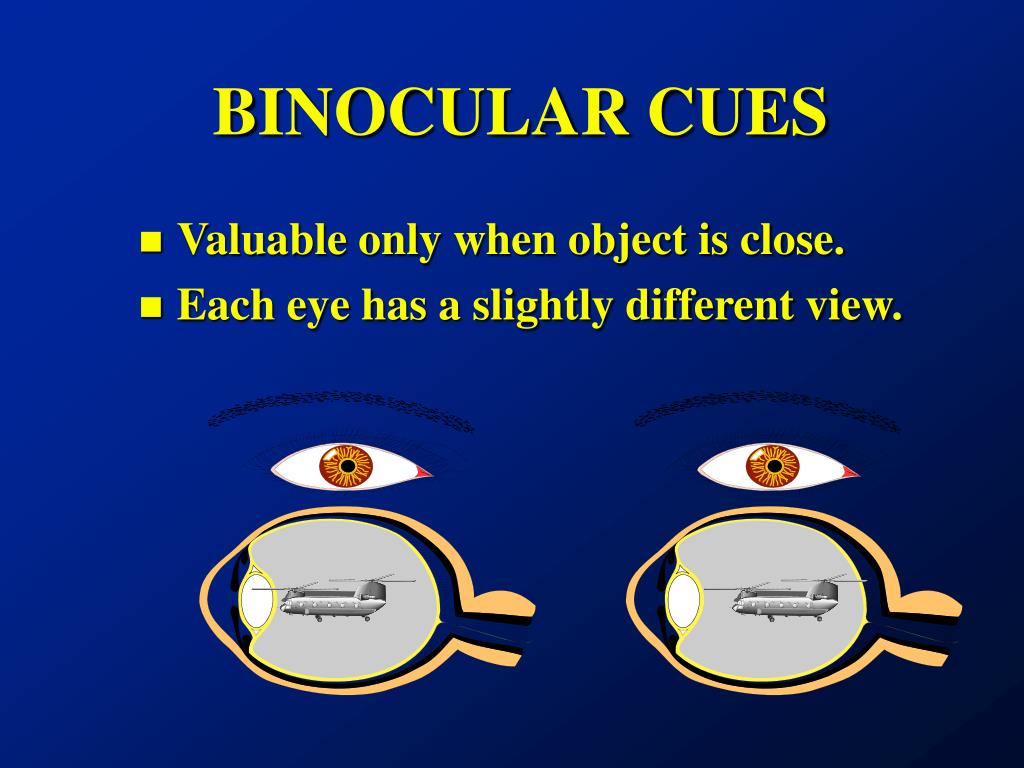

Familiar objects influenced adjusted position from size but not adjusted size from position. In all experiments, the adjusted target size and positions were not consistent with their initially presented positions and sizes and were made larger and moved further away on average. They either positioned it in the scene at the distance they thought was correct based on its size or adjusted the target to the correct size based on its position in the scene.
Binocular cues series#
In a series of online experiments, participants viewed a target representing their smartphone rendered within a 2D scene. In this study, we tested whether people could use an object’s size and its position in a 2D image to determine its distance. These findings demonstrate that visual information for action in HMD-VR is processed differently compared to real 3D objects and is susceptible to perceptual effects, which could affect motor skill training in HMD-VR.ĭepth information is limited in a 2D scene and for people to perceive the distance of an object, they need to rely on pictorial cues such as perspective, size constancy and elevation in the scene. These results show that visual processing of actions towards virtual 3D objects in HMD-VR may involve holistic processing of object shape. We found Garner interference effects for reaction times to reach maximum grip aperture and to complete movement. In an initial study, we used a Garner interference task to examine whether vision-for-action in HMD-VR is processed holistically and hypothesized that vision-for-action towards virtual 3D objects in HMD-VR would result in a Garner interference effect, suggesting holistic processing. Thus, actions towards virtual 3D objects in HMD-VR may be processed more like 2D objects and involve holistic processing, which is susceptible to perceptual effects. In HMD-VR, distances are often underestimated, and the environment can appear flatter compared to the real world. However, actions towards two-dimensional (2D) objects are processed holistically and are susceptible to perceptual effects. In the real world, actions towards three-dimensional (3D) objects are processed analytically and are immune to perceptual effects, such as processing object dimensions irrelevant to performing the action (i.e., holistic processing). However, it remains unclear how visual information for action is processed in an HMD-VR environment. Immersive virtual reality using a head-mounted display (HMD-VR) is increasing in use for motor learning and motor skill training.

These results show that linear perspective and binocular cues, in particular, improve the accuracy and precision of distance estimates in virtual reality across a range of distances typical of many indoor environments. The addition of binocular cues, when rich pictorial cues were already available, reduced both the bias and variability of estimates. While there was no evidence of nonlinear compression of space, participants did tend to underestimate distance linearly, but this bias was reduced with the addition of each cue. We measured accuracy by identifying systematic biases in responses and precision as the standard deviation of these responses. Each task was performed in four environments varying in the available cues. In the second and third tasks, participants set the size of a sphere, presented at the same distances and at eye-height, to match that of a hand-held football. In the first task, participants positioned two spheres so as to divide the egocentric distance to a reference stimulus (presented between 3 and 11 m) into three equal thirds. We assessed (1) whether space is nonlinearly distorted (2) the degree of size constancy across changes in distance and (3) the weighting of pictorial versus binocular cues in VR. As additional cues are made available, distance perception is predicted to improve, as measured by a reduction in systematic bias, and an increase in precision. We assessed the contribution of binocular disparity and the pictorial cues of linear perspective, texture, and scene clutter to the perception of distance in consumer virtual reality.


 0 kommentar(er)
0 kommentar(er)
